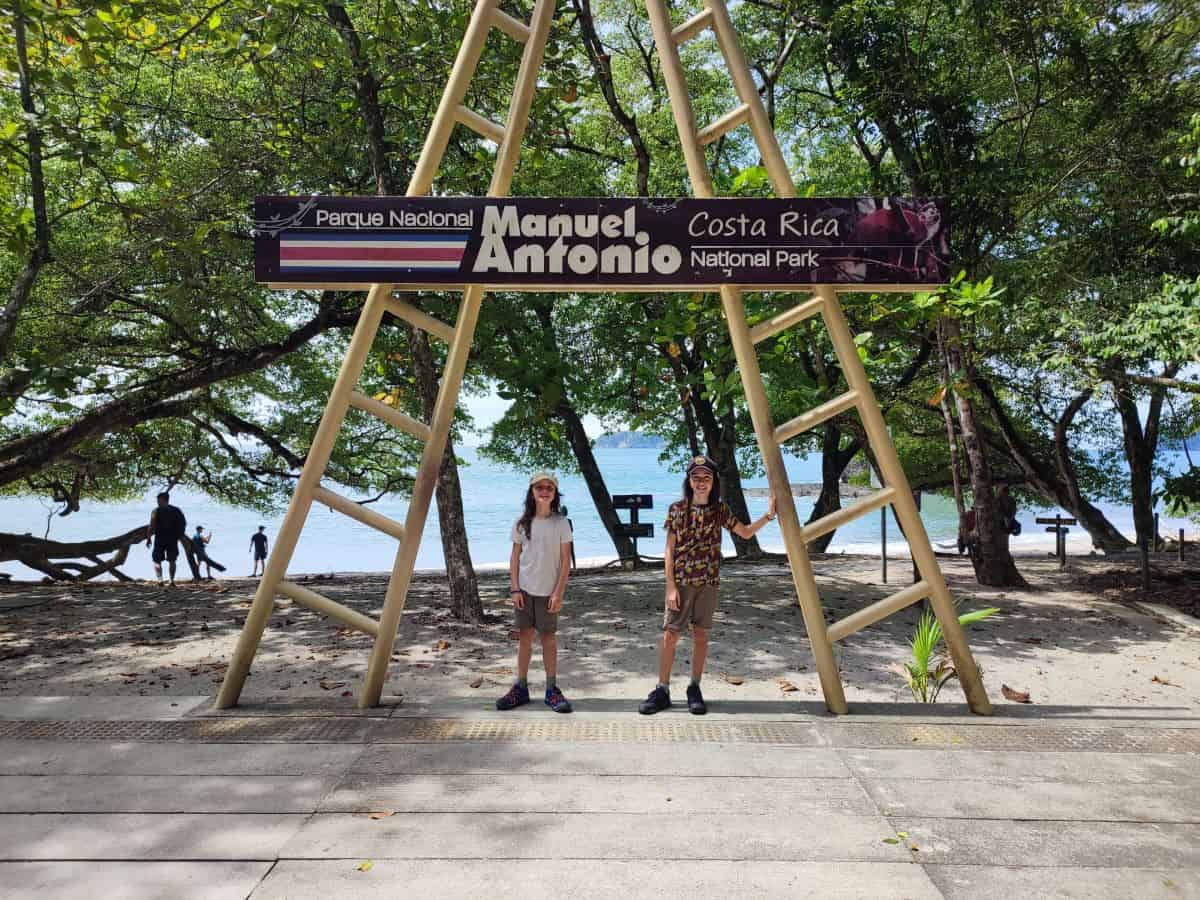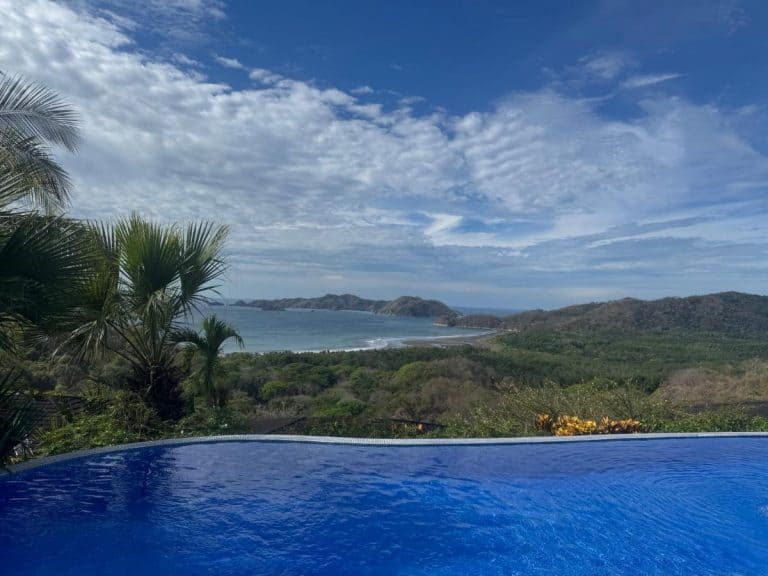Visiting Manuel Antonio National Park with Kids
Thompsons vs the World contains affiliate links and is a member of the Amazon Services LLC Affiliates Program. Making a booking via these links will mean that we receive a small fee but this is at absolutely no cost to you. The price you pay will always remain the same. For more information please see our Privacy Policy.
If like me, the image of Costa Rica you have in your mind includes lush jungle, wildlife galore and the most beautiful, pristine beaches you’ve ever seen, then Manuel Antonio National Park is the place to make these dreams a reality. There’s a reason why this is one of the top destinations in Costa Rica. And if you’re planning on visiting Manuel Antonio National Park with kids then you might be relieved to hear that it’s much easier than you might think!
In just one day trip you can marvel at sloths in the treetops, chuckle at the antics of the monkeys that roam the park, be amazed by the size of the huge iguanas that are EVERYWHERE, explore the diverse fauna that actually makes up the rainforest, watch hundreds of hermit crabs as they scuttle about on the sand AND cool off in the gentle waves on one of the most beautiful beaches in the world.
We spent several weeks travelling in Costa Rica as a family and can confidently say that this is one place you shouldn’t miss. Of all the destinations we visited on our travels around the world, Manuel Antonio still holds a pretty special spot in our hearts.
In this guide we’ll breakdown all the practical info you need for planning the PERFECT trip to Manuel Antonio National Park with kids. Including the mistakes we made (so you don’t have to make the same ones!).
Table of Contents
- Why visit Manuel Antonio National Park?
- How do you get to the Manuel Antonio area?
- How do you get to Manuel Antonio National Park?
- What is the Manuel Antonio entrance fee and how do you book tickets?
- What to wear to Manuel Antonio National Park
- What to pack for a visit to Manuel Antonio
- What are the walking trails like inside the park?
- Do you need to hire a guide at Manuel Antonio?
- What are the beaches in Manuel Antonio like?
- Best places to stay in Manuel Antonio
- Tips for visiting Manuel Antonio National Park with kids
- Planning a family vacation to Costa Rica?
Why visit Manuel Antonio National Park?
If you’re travelling to Costa Rica with kids then trust me, it would be madness to miss Manuel Antonio from your itinerary! Here’s a few quick reasons why:
- It’s packed full of wildlife – if you’ve come to Costa Rica for the biodiversity then this is a GREAT place to start. Sloths, monkeys, giant iguanas, land crabs, snakes, leaf-cutting ants and more can all be spotted here.
- The hikes are easy, even for kids. Flat wooden walkways loop around the park and are easy to navigate.
- As such a popular destination it’s easy to get here from pretty much anywhere else in Costa Rica
- The glorious beaches alone are enough of a draw – the stuff of absolute tropical dreams
If you only have time to visit one national park in Costa Rica, then this should be it.
How do you get to the Manuel Antonio area?
As Manuel Antonio is included on the itinerary of most travellers to Costa Rica, it’s pretty well-served in terms of transport. Your options really depend on your budget and how much you want to spend.
By Bus
If you’re on a budget then the public bus system is your best bet. As we were sticking to very much a backpacker budget for our travels in Costa Rica, this was what we opted for.
There’s no ‘central’ bus service in Costa Rica, just a series of smaller companies that all operate different routes. I would highly recommend using the guide on the Visit Costa Rica website to figure out which route/company you need (depending on where you are travelling from).
Our journey from San Jose took around 3-hours in total. To give you an idea, our tickets cost £42.97 in total for us (three adults and two kids). The bus was on-time and comfortable. There were some fab views as we drove along the Pacific coast down towards Manuel Antonio.
By shuttle
A faster but more expensive option is to book on to one of the shared or private shuttle services that run across Costa Rica. Interbus operate along most of the major routes throughout Costa Rica and offer a door to door service. This is very easy and convenient but obviously comes at a price! When we costed the journey from San Jose to Manuel Antonio it came in at just over £200.
We did use Interbus at later points in the trip in harder to reach areas of Costa Rica when there were very few other options. If you’re visiting Costa Rica as a family and trying to save on the budget, I would save this option for a time when you REALLY need to use it.
By car
Alternatively you can opt to hire a car and drive. I was initially reluctant to drive in Costa Rica as I was very nervous about the road conditions. However, we DID opt to hire a car for several weeks in the end and it was MUCH easier than I had thought!
The road to Quepos/Manuel Antonio from San Jose is generally an easy drive with long stretches of highway, little traffic and no river crossings. A word of warning though – the traffic in San Jose is INSANE so you might want to avoid hiring/returning a car from here if you can.
We opted to use Discover Cars for all our car hire in Central America and had a great experience with them every time.
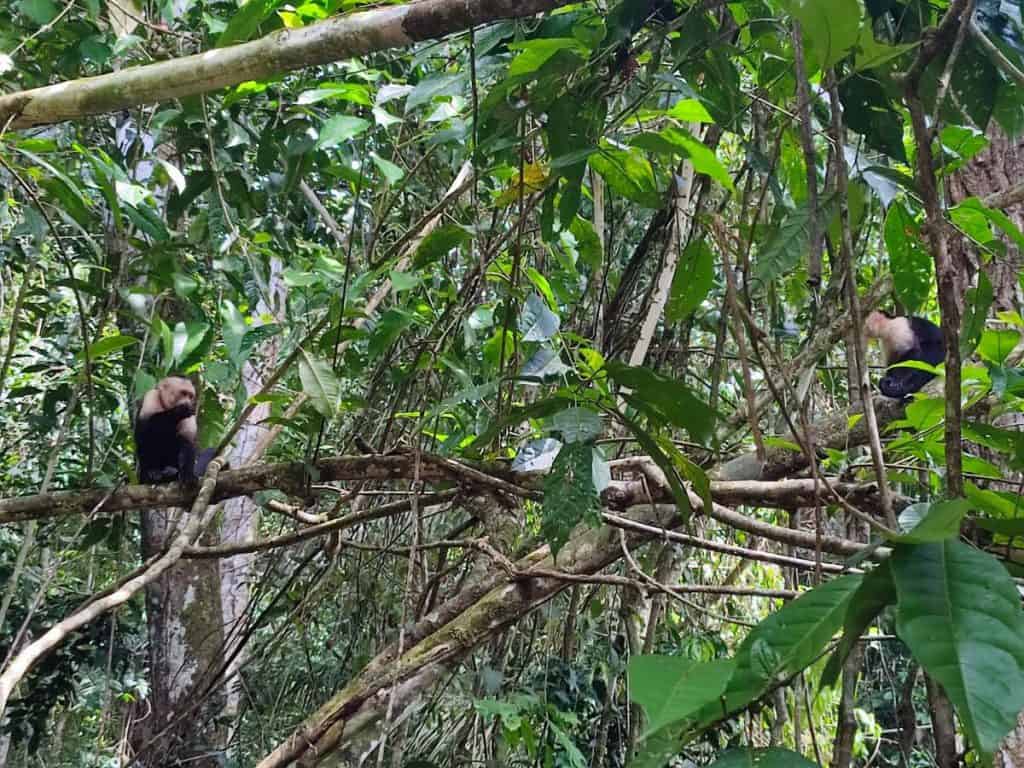
How do you get to Manuel Antonio National Park?
So you’ve got yourselves to Manuel Antonio, but now how do you get to the national park itself?
On foot
If you’re staying in Manuel Antonio village itself you can pick up the trail to the national park easily – your hotel (or any of the helpful locals) will be able to direct you.
By car
If you have your own wheels, it’s an easy drive down to the park from any of the hotels strung along the Manuel Antonio-Quepos road, or further up the coast. There is no official car park for the national park but there are many unofficial ones that have been set-up – the cost of these can vary wildly so you may have to negotiate!
You’ll see the signage for these car parks as soon as you drive into Manuel Antonio village.
By bus
The public bus service from Quepos to Manuel Antonio is regular and reliable, with stops all the way along the road from Quepos. It runs approximately every 30mins from 5.30am onwards.
We used the bus to get to the national park and down to the beach in Manuel Antonio village and it was easy and cheap. This is the best option if you’re on a budget and trying to keep costs down during your family travels in Costa Rica.
By taxi
You can of course opt for a private taxi to/from the park – this will be the more expensive option but will drop you right by the park entrance. Ubers are available in the area or you can ask your hotel to call a private taxi.
You can also take a day trip to Manuel Antonio National Park from other towns in Costa Rica if you’re really short on time. However it’s a lovely area to stay in so worth at least a couple of days on any Costa Rica itinerary.
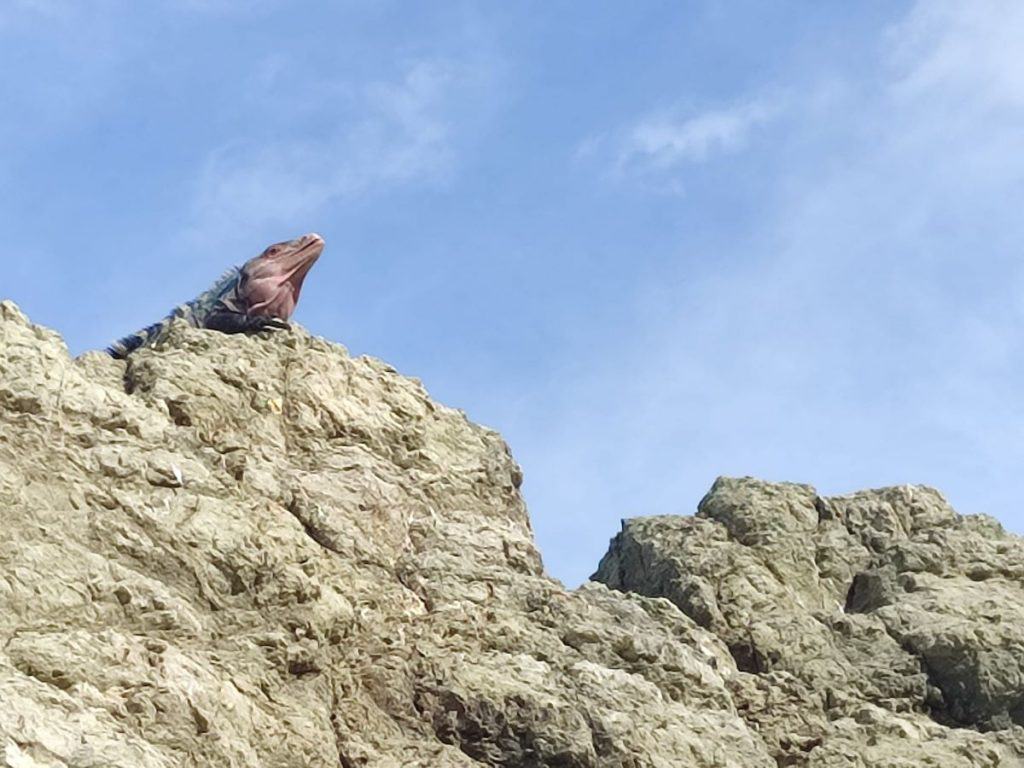
What is the Manuel Antonio entrance fee and how do you book tickets?
You need to book tickets in advance if you want to visit the National Park here as visitor numbers are limited to protect the ecosystem. As soon as you know your dates for Costa Rica I would absolutely recommend booking your tickets for Manuel Antonio too.
You can book tickets online via the SINAC website here. At the time of writing (August 2025) tickets are priced as follows:
Adults: £14.20/US$18.08
Children (aged 2-12): £4.40/US$5.65
The park is closed on Tuesdays so make sure you factor this in to your planning. The park opens from 7am-4pm. The earlier you can get there, the quieter the park will be (and you’ll escape some of the heat too). The beaches close at 3pm to make sure that you have enough time to walk back to the park entrance by the closing time of 4pm.
What to wear to Manuel Antonio National Park
Whatever the time of year that you visit, it’s likely to be hot and humid. You only need to look at the red, shiny faces in all our family snaps from the park to see how sweaty we all ended up!
Make sure you wear lightweight clothing that’s not going to make the sweatiness even worse! We love the Nosilife range from Craghoppers as it’s lightweight and built for travel AND includes built-in mosquito repellent. We had a whole range of tops, shorts and trousers that we wore to death in tropical places on our family gap year.
You’ll also need some proper footwear for hiking/walking a distance in (so maybe leave the Crocs at home for this one). Either hiking trainers/boots or tough sandals (we love the Keen ones) would be best.
Caps or hats for everyone will help keep the worst of the sun away. And don’t forget to pack your swimkit too so you can take a dip in the glorious aquamarine sea.
What to pack for a visit to Manuel Antonio
First up on this list is what NOT to pack on a trip to Manuel Antonio National Park. Do not do what we did and spend the morning making a delicious packed lunch – only to discover that you are absolutely not allowed to take ANY food inside the national park. Having to chuck all our carefully made food in the bin at the entrance was not exactly the best start to our visit!
Only drinking water is allowed inside the park – bags are checked so any food stashed away will be found and removed. Water MUST be in reusable bottles – single use plastic is also not allowed. If you’re forgotten to pack water bottles then these can be bought from the stands outside the park entrance.
We also managed to leave the backpack with our swimming kit at home (talk about a packing nightmare!). It was so hot and the sea was so inviting that we all just swam in our clothes anyway.
So basically, DON’T follow our example! Instead, I would recommend packing the following stuff for visiting Manuel Antonio with kids.
- Lightweight travel towels
- Swimkit
- Sunscreen (SPF50+)
- Plenty of drinking water per person. It’s a hot and sweaty hike and you’ll plenty of rehydration
- Camera or decent phone camera for capturing shots
- Binoculars
- Insect repellent
Remember you’ll be hiking through the park for the day, so make sure you only pack what you can comfortably carry.
What are the walking trails like inside the park?
Once you get into the park you’ll discover that it’s pretty easy to navigate. There are wooden walkways that run along most of the trails which are flat and easy to traverse, even for kids.
The main trail through the park is a loop. It takes you through the denser initial jungle section where monkeys swing from the trees, leaf-cutting ants march along the branches and land crabs burrow into the mud beneath the walkways. After around an hour of walking (at a fairly slow pace if you’ve got kids in tow) you come out at the first of the two beaches, Playa Espadilla Sur.
Between the beaches you’ll find a raised platform that you can climb for a truly magnificent view over the treetops and across the Pacific Ocean. Despite the heat and slightly tired legs, it’s definitely worth the effort to get to the top!
You can opt to take the flat wooden walkways back the way you came to the entrance of the park. The second part of the trail loop after the beaches does involve an uphill climb, then a descent on uneven ground. Our boys (aged 7 and 9 at the time) and my Mum (in her early 70s) managed this without any problems. However, if you don’t fancy the extra effort (particularly if you’ve got younger kids) then you can head back the way you came via the wooden walkways. You’re likely to spot a similar amount of wildlife whichever route you opt for.
Do you need to hire a guide at Manuel Antonio?
If you really want to maximise your chances of spotting wildlife then you can hire a guide at the park entrance or book online in advance. The local guides are experts on what you can expect to see and where in the park. If you’re short on time and this is likely to be your only national park stop in Costa Rica, then I would recommend a guide.
As we had several weeks in Costa Rica we opted NOT to go with a guide as we felt we had plenty of time to see the abundance of wildlife on our travels. On our own, we spotted dozens of monkeys, land crabs, iguanas, leaf-cutting ants, hermit crabs and two sloths. Including one sloth that had popped down from it’s tree for it’s weekly poo and was happily sitting on the ground right in front of us. Given that spotting a sloth in Costa Rica was pretty much top of all our lists, getting to see this in our first couple of days in the country was very special!
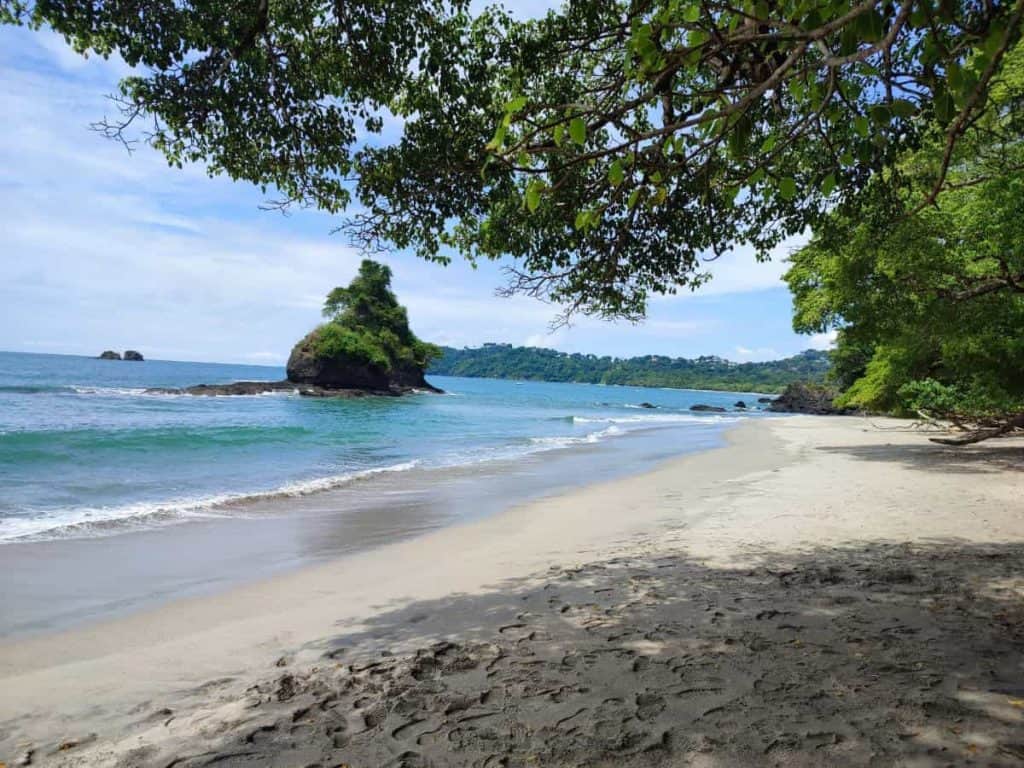
What are the beaches in Manuel Antonio like?
We visited a LOT of beaches during our travels in Costa Rica and Playa Manuel Antonio was without a doubt one of the most beautiful. It was also one of the best beaches we found in Costa Rica for kids.
There are in fact two beaches in Manuel Antonio National Park. If you follow the main trail the first you come to will be Playa Espadilla Sur. This is a rugged and spectacular stretch of beach; however, it has stronger riptides and bigger waves than Playa Manuel Antonio so is less safe for swimming.
Once you hit Playa Espadilla Sur keep going and the trail will lead you through to the second beach on the other side of the park – this is Playa Manuel Antonio.
It’s an absolutely pristine stretch of sparkling white sand, backed by lush jungle behind and looking out over the gorgeous (and very inviting!) aquamarine sea. The waves are pretty gentle – we all spent hours swimming here in the shallows.
There is shade beneath the trees that line the beach where you can relax. If you’re lucky (as we were!) you might even spot the odd sloth dozing in the treetops!
Whilst there are no facilities at the beach, this is easily a spot where you can spend a couple of hours cooling off in the sea while the kids swim or play on the sand. The beaches closes at 3pm to allow you enough time to get back to the park entrance for the closing time of 4pm. Bear this in mind when booking your tickets to make sure you factor in enough time.

Best places to stay in Manuel Antonio
There’s a ton of family-friendly places to stay both in Manuel Antonio village and along the road between Quepos and Manuel Antonio.
If you stay in Manuel Antonio itself you’ll have easy access to the national park and places to eat on your doorstep. But if you opt to stay along the Quepos-Manuel Antonio you’ll have AMAZING views out over the jungle and out to sea. Plus it’s pretty easy to get to Manuel Antonio on the public bus route that runs regularly along the road.
Where to stay on the Quepos-Manuel Antonio road
Pura Natura Lodge
This is a brilliant option if you’re on a budget. The view from the lodge is spectacular – it was the Costa Rican panorama from my dreams, lush greenery and then the sparkling Pacific Ocean beyond. The lodge had a huge decked area with hammocks where you could hang out and watch the sunset (if you were quick – the sun goes down pretty sharpish in these parts!).
The apartments come with two rooms (each with a double and a set of bunk beds) and a kitchen/lounge area, with a terrace outside looking out across THAT view. There is also aircon in all the rooms which was a must in these parts after a day of hiking through the jungle.
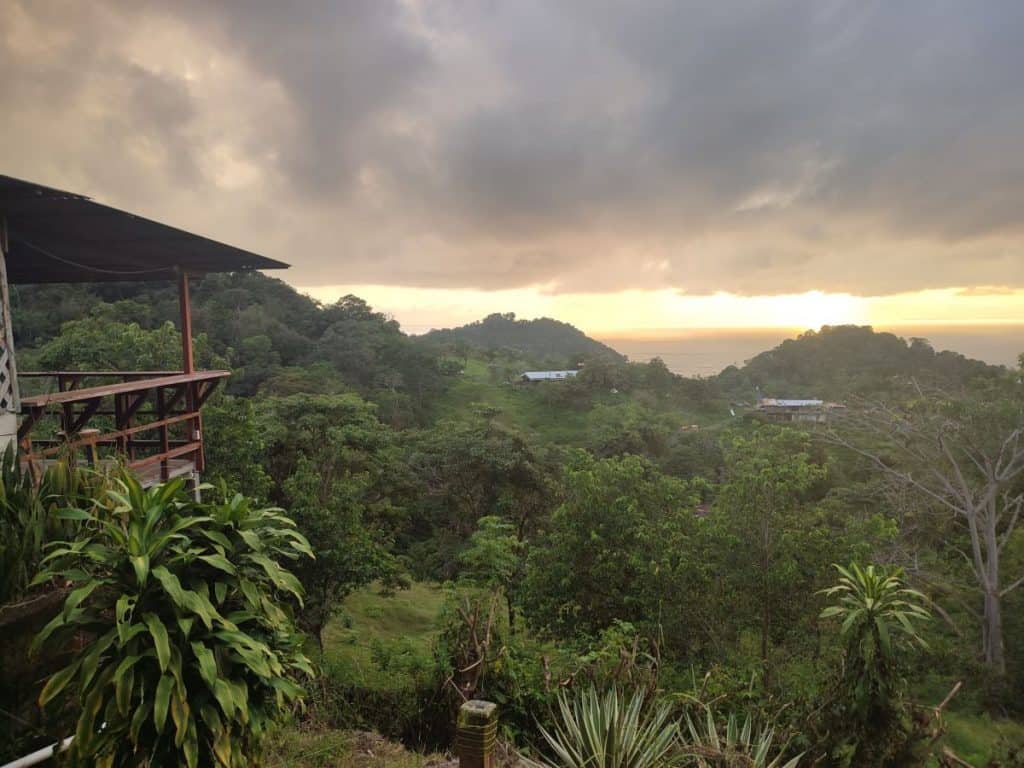
Where to stay in Manuel Antonio Village
Igloo Beach Lodge
If it’s a beachfront location you’re craving, then this is your best bet. It’s located slightly away from everything else so is quiet and peaceful, but just a few minutes walk to the sea and sand. The beds are SUPER comfortable and the bonus of a pool is fab when you want to cool off after a hot day of hiking!
Tips for visiting Manuel Antonio National Park with kids
- Make sure you book online in advance; entrance tickets DO sell out
- Pack as much drinking water as you can carry. It’s hot and humid in the park (like most of the rest of Costa Rica!) and kids can get dehydrated faster than you think.
- Get to the national park as early as you can in the morning to avoid both the heat and the crowds
- Save your swimming for Playa Manuel Antonio – the beach on the opposite side of the trail (Playa Espadilla Sur) is less busy but the sea is not as calm and it has strong riptides.
- Talk to children in advance about how to behave around wild animals. This includes absolutely NOT feeding the monkeys, not attempting to touch any animals they may encounter and keeping a safe distance at all times.
- Remember NOT to take selfies with any of the wildlife. The Costa Rican government has been campaigning for tourists to treat the flora and fauna of the country with respect, and this includes how you photograph the animals. Pictures of humans with wild animals is prohibited under Costa Rican law.
- If you’re travelling with younger children then consider taking a sling or baby/toddler carrier. Whilst most of the walkways are flat the loop trail isn’t suitable for pushchairs/strollers and those little legs are likely to get tired!
Planning a family vacation to Costa Rica?
If you’re planning a family adventure to Costa Rica, then download our free Costa Rica Travel with Kids guide here! It includes all the info you need for planning an amazing trip, including a two-week itinerary curated especially for families.

